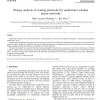Free Online Productivity Tools
i2Speak
i2Symbol
i2OCR
iTex2Img
iWeb2Print
iWeb2Shot
i2Type
iPdf2Split
iPdf2Merge
i2Bopomofo
i2Arabic
i2Style
i2Image
i2PDF
iLatex2Rtf
Sci2ools
COMCOM
2008
2008
Energy analysis of routing protocols for underwater wireless sensor networks
Underwater wireless sensor networks consist of a certain number of sensors and vehicles that interact to collect data and perform collaborative tasks. Designing energy-efficient routing protocols for this type of networks is essential and challenging because sensor nodes are powered by batteries, which are difficult to replace or recharge, and because underwater communications are severely affected by network dynamics, large propagation delays and high error probability of acoustic channels. The goal of this paper is to analyze the total energy consumption in underwater acoustic sensor networks considering two different scenarios: shallow water and deep water. We propose different basic functioning principles for routing protocols in underwater wireless sensor networks (relaying, direct transmission and clustering) and analyze the total energy consumption for each case, establishing a comparison between them.
| Added | 09 Dec 2010 |
| Updated | 09 Dec 2010 |
| Type | Journal |
| Year | 2008 |
| Where | COMCOM |
| Authors | Mari Carmen Domingo, Rui Prior |
Comments (0)

